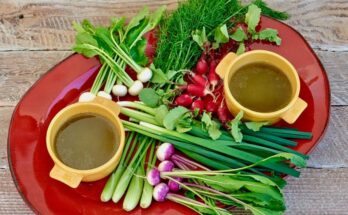Halal White Sauce Recipe: Halal white sauce is a creamy, tangy, and flavorful condiment that has become a signature element of Middle Eastern and Mediterranean-inspired street food, particularly in New York City’s famous halal carts. It’s most commonly drizzled over chicken and rice platters, gyros, and kebabs, adding a refreshing yet indulgent taste that balances out the spices of grilled meats and rice. Unlike generic sauces like ranch or mayonnaise, halal white sauce has a distinct blend of yogurt, mayonnaise, garlic, lemon juice, and spices, making it unique. Its halal designation simply means that the ingredients and preparation align with Islamic dietary laws, ensuring it’s permissible for Muslims to consume.
This sauce isn’t just about taste—it’s about culture and identity. For many, halal white sauce represents the flavor of comfort food and the vibrancy of bustling food carts. Its smooth texture and rich flavor make it stand out, and once you try it, you’ll understand why people often ask for “extra sauce” on their platters. It’s more than just a topping; it’s the magic ingredient that ties the whole dish together.
Why is it Popular in Street Food and Home Kitchens?
The popularity of halal white sauce can be traced back to the iconic halal carts of New York, where it became the defining condiment for chicken and rice platters. The contrast of spicy red chili sauce with cool, creamy white sauce created a perfect balance that kept customers coming back. Today, it’s not only a staple of street food but also a favorite in home kitchens around the world.
Home cooks love it because it’s simple to make, requires no cooking, and pairs well with a wide variety of foods. Whether you’re having grilled meats, roasted vegetables, or even sandwiches, this sauce can elevate the flavor instantly. Unlike bottled condiments that are loaded with preservatives, making it at home ensures freshness and customization—you can tweak it to match your personal taste preferences.
Health Benefits of Making It at Home
While the store-bought or cart versions of white sauce might be rich and calorie-dense, preparing it at home gives you full control over the ingredients. Using low-fat yogurt instead of full-fat, opting for olive oil mayonnaise, and balancing the seasonings can make it a healthier choice. Yogurt provides probiotics that support gut health, while lemon juice adds vitamin C. Garlic not only enhances flavor but also offers antimicrobial and immune-boosting benefits.
In short, making halal white sauce at home isn’t just about flavor—it’s about healthier eating and cleaner ingredients. You can enjoy the same indulgence without the guilt, making it perfect for both foodies and health-conscious eaters.
Ingredients You’ll Need
Core Ingredients for Authentic Halal White Sauce
To get that authentic street food flavor, you’ll need a handful of simple, pantry-friendly ingredients. The core components include:
- Mayonnaise – This provides the creamy base and rich texture. Opt for full-fat mayo for authenticity or olive oil mayo for a lighter version.
- Greek Yogurt – Adds tanginess and a smooth consistency while balancing the richness of mayonnaise.
- Lemon Juice – Brightens up the sauce and cuts through the heaviness of the mayo.
- Garlic – Freshly minced or grated garlic gives a bold flavor. Roasted garlic can be used for a milder taste.
- Vinegar – Just a splash to enhance acidity and add sharpness.
- Sugar or Honey (Optional) – Helps balance acidity with a hint of sweetness.
- Salt and Pepper – Essential seasonings for balance.
These ingredients come together to create the classic halal white sauce flavor profile—creamy, tangy, garlicky, and slightly sweet.
Optional Ingredients for Extra Flavor
While the core ingredients will give you a great white sauce, adding optional ingredients can elevate it further:
- Fresh Herbs (Dill, Parsley, or Cilantro) – Add freshness and color.
- Cumin or Coriander – For a subtle earthy undertone.
- Olive Oil – A drizzle enhances creaminess and gives a Mediterranean flair.
- Hot Sauce or Cayenne Pepper – For those who enjoy a kick of spice.
Experimenting with these extras allows you to create your own version of the sauce while still keeping it true to its halal street food origins.
Ingredient Substitutions for Dietary Needs
Everyone has different dietary needs, and the good news is that halal white sauce can be easily adapted:
- Dairy-Free: Swap Greek yogurt with unsweetened coconut yogurt or soy-based alternatives.
- Low-Calorie: Use light mayonnaise and non-fat Greek yogurt.
- Keto-Friendly: Stick to full-fat versions and avoid adding sugar.
- Vegan: Replace mayo with vegan mayonnaise and yogurt with plant-based yogurt.
With these substitutions, you can still enjoy the deliciousness of halal white sauce without compromising on your diet or health requirements.
Tools and Equipment Required
Mixing Bowls and Whisks
At its core, halal white sauce is a no-cook recipe, which means all you really need are some basic kitchen tools. A sturdy mixing bowl and a whisk are essential to combine ingredients smoothly. A whisk works better than a spoon because it helps break down lumps, especially when blending thick mayonnaise with yogurt. If you want a truly silky sauce, whisking thoroughly is non-negotiable.
Blenders and Food Processors
For those who prefer an ultra-smooth texture or want to incorporate herbs and garlic seamlessly, a blender or food processor can make the job easier. It ensures that garlic is finely blended into the sauce without leaving chunks. If you’re making a large batch for a family dinner or a party, using a blender saves time and effort.
Storage Containers for Freshness
Since halal white sauce tastes better when it rests and the flavors meld, proper storage is key. Airtight glass jars or BPA-free plastic containers are ideal for keeping it fresh in the refrigerator. Always make sure to store it in clean containers to prevent bacterial growth and spoilage. Glass containers are particularly recommended since they don’t absorb odors.
Step-by-Step Guide to Making Halal White Sauce
SStep 1 – Preparing the Base
Begin by gathering your ingredients. The base of halal white sauce typically includes mayonnaise and plain yogurt or sour cream. These ingredients provide the rich, creamy foundation that makes the sauce so irresistible. Measure them out and have them ready in a mixing bowl.
Step 2 – Adding the Creamy Components
Combine the mayonnaise with the yogurt (or sour cream) in your bowl. Stir until smooth and well blended. This mixture forms the core of the sauce, giving it the signature creamy texture and tangy undertone that pairs perfectly with grilled meats, rice, or wraps.
Step 3 – Balancing with Spices and Seasonings
Now it’s time to build flavor. Add garlic powder, onion powder, lemon juice, salt, and a pinch of black pepper. For a little extra depth, some recipes include sugar or vinegar to balance the tanginess. Adjust these seasonings according to your taste—halal white sauce should be creamy, slightly tangy, and mildly garlicky.
Step 4 – Blending for the Perfect Texture
To achieve a smooth, restaurant-style consistency, blend the sauce using a whisk, immersion blender, or food processor. This ensures the flavors are evenly distributed and the sauce has that silky finish. If it feels too thick, add a splash of water or milk to loosen it up.
Step 5 – Resting and Storing for Maximum Flavor
Cover the sauce and refrigerate it for at least 1–2 hours before serving. This resting period allows the flavors to meld together beautifully. Store it in an airtight container in the fridge, where it will stay fresh for up to a week. Serve chilled over chicken, lamb, falafel, rice, or even as a dip for fries.
Tips and Tricks for the Perfect White Sauce
How to Get the Right Consistency
Consistency is everything when it comes to white sauce. Too thick, and it clumps; too thin, and it runs all over your food. To hit the sweet spot, aim for a pourable sauce that clings lightly to food. The best way to test is by dipping a spoon—if the sauce coats the back without dripping too quickly, you’ve nailed it. Always adjust gradually by adding small amounts of yogurt, mayo, or water until you get it right.
Adjusting Spice Levels
Not everyone loves the same spice intensity. Some like a mellow, creamy sauce, while others crave a punch of garlic and pepper. The trick is to start mild and build up. Add spices slowly, taste-testing after each adjustment. For a spicier version, sprinkle in cayenne pepper or a dash of hot sauce. For a herby touch, fold in fresh dill or parsley. Customizing spice levels ensures everyone at the table enjoys it.
Keeping the Sauce Fresh Longer
Want your halal white sauce to last all week? The secret lies in proper storage. Always refrigerate it in an airtight container and avoid leaving it out for long periods. If you want to extend shelf life, skip adding fresh herbs in the main batch and instead sprinkle them on when serving. This prevents the sauce from spoiling quickly and keeps it tasting fresh.
Best Ways to Serve Halal White Sauce
With Chicken or Beef Gyros
If there’s one dish where halal white sauce shines brightest, it’s with gyros. The tender, spiced meat wrapped in warm pita bread, topped with fresh vegetables, becomes irresistible once drizzled with creamy white sauce. The cool tang of the sauce balances the richness of beef or chicken perfectly. It doesn’t just add moisture; it elevates every bite. Many gyro lovers even double up on the sauce, making it the star of the show rather than just a side condiment. Whether you’re making gyros at home or ordering from a street cart, this pairing is a must-try.
Over Rice Bowls and Salads
Rice platters are another iconic pairing for halal white sauce. A steaming bed of spiced rice topped with grilled chicken, lamb, or falafel is never complete without a generous drizzle of white sauce. It softens the spice and ties the dish together. Similarly, it makes an excellent salad dressing. If you’re bored with plain vinaigrettes, swap in white sauce for a creamy, tangy alternative that turns ordinary greens into something spectacular. Its thick texture helps it cling to vegetables, ensuring every bite is flavorful.
As a Dipping Sauce for Snacks
Don’t limit white sauce to meals—it’s also a fantastic dip. Use it with fries, wedges, chicken wings, or even vegetable sticks. Its versatility means it pairs with both savory and spicy snacks. Imagine dunking crispy falafel balls into a cool, garlicky white sauce—it’s pure bliss. For game nights, family gatherings, or casual snacking, keeping a bowl of halal white sauce on the table will make you the favorite host.
Variations of Halal White Sauce
Spicy Version
If you love heat, turn up the spice by adding cayenne pepper, chili flakes, or a splash of hot sauce. The creamy base will balance the spice beautifully, giving you a sauce that’s fiery yet soothing. This version pairs especially well with grilled meats or spicy rice bowls, giving an extra punch to every bite.
Low-Fat and Healthy Version
For those watching calories, swap full-fat mayo for light or olive-oil-based mayo, and use non-fat Greek yogurt instead of the full-fat version. This reduces calories without sacrificing flavor. The lemon juice and garlic keep the sauce tasting bright and fresh, so you won’t miss the richness. It’s perfect for health-conscious foodies who want indulgence without guilt.
Vegan-Friendly Alternative
Making this sauce vegan is surprisingly easy. Replace mayo with vegan mayonnaise and use coconut yogurt or soy yogurt instead of dairy-based ones. The flavor stays remarkably similar, and the texture remains creamy. For added depth, a drizzle of olive oil can make the vegan version just as indulgent as the original.
Common Mistakes to Avoid
Overpowering with Garlic
Garlic is essential, but too much of it can turn your sauce bitter and overly pungent. Fresh garlic is strong, so stick to one or two cloves, depending on your batch size. If you’re unsure, start small—you can always add more later. Roasted garlic is a safer option if you prefer a milder profile.
Incorrect Balance of Yogurt and Mayonnaise
The ratio of mayo to yogurt makes or breaks the sauce. Too much yogurt, and it becomes too tangy and runny. Too much mayo, and it’s heavy and cloying. The ideal balance is usually equal parts, but you can adjust slightly depending on your preference. Always taste as you go to find the perfect middle ground.
Skipping the Resting Time
Perhaps the biggest mistake is using the sauce immediately after mixing. Resting in the fridge allows the flavors to develop and mellow out. Garlic, in particular, needs time to blend with the creamy base. Skipping this step results in a flat-tasting sauce that doesn’t deliver the same depth. A little patience goes a long way toward achieving perfection.
Nutritional Value of Halal White Sauce
Calories per Serving
A typical serving (about 2 tablespoons) of halal white sauce contains around 120–150 calories, depending on the mayo and yogurt used. This makes it a moderate-calorie condiment, perfect in small amounts but worth monitoring if you’re watching your intake.
Protein, Fat, and Carb Breakdown
Most of the calories come from fat in mayonnaise. Yogurt adds protein and reduces heaviness, while lemon juice and spices contribute negligible calories. On average, per serving you’ll get:
- Fat: 12g
- Protein: 2g
- Carbohydrates: 1–2g
This profile makes it filling and satisfying, especially when paired with high-protein dishes like chicken or lamb.
Healthier Substitutes for Diet-Friendly Versions
To lighten the sauce, use Greek yogurt as the dominant base and reduce mayonnaise. You can also experiment with avocado-based mayo for a healthier fat source. For keto diets, stick with full-fat versions. For low-calorie needs, choose non-fat Greek yogurt and light mayo. These swaps help maintain flavor while tailoring nutrition to your needs.
Storing and Shelf Life
Refrigeration Tips
Store halal white sauce in a sealed glass container in the refrigerator. Properly stored, it stays fresh for 5–7 days. Always stir before serving, as separation can occur naturally.
Freezing White Sauce – Is It Possible?
While technically you can freeze it, freezing often alters the texture, making it grainy when thawed. If you must freeze, do so in small batches and blend again after thawing to restore smoothness. However, fresh is always best.
Signs That the Sauce Has Gone Bad
If the sauce develops a sour smell, unusual color, or watery separation that doesn’t mix back in, it’s time to discard it. Trust your senses—when in doubt, throw it out. Eating spoiled sauce can cause foodborne illness, so it’s better to be safe.
FAQs about Halal White Sauce Recipe
Can I Make It Without Yogurt?
Yes, though it changes the flavor. You can use extra mayo and a splash of milk or cream to maintain creaminess, but you’ll miss the tang yogurt provides.
How Long Can It Stay Fresh in the Fridge?
Typically 5–7 days if stored in an airtight container. For best flavor, use it within the first 3–4 days.
What’s the Difference Between Halal White Sauce and Ranch Dressing?
While both are creamy, ranch is herb-forward with dill and chives, while halal white sauce is tangier and relies more on garlic and lemon. The two are distinct in both taste and cultural roots.
Can I Use It as a Salad Dressing?
Absolutely. Thin it slightly with water or milk to make it pour more easily over greens. It works wonderfully with both fresh and grilled vegetable salads.
Is It Gluten-Free?
Yes, the basic recipe is naturally gluten-free. Just make sure your mayo and yogurt brands are certified gluten-free to avoid cross-contamination.
Conclusion
Halal white sauce isn’t just a condiment—it’s the magic touch that transforms a good meal into an unforgettable one. With its creamy base, tangy undertones, and garlicky punch, it’s no wonder this sauce has become a global street food sensation. Whether you drizzle it over gyros, spoon it onto rice bowls, or use it as a dip, the versatility is unmatched. The best part? You can easily make it at home, customize it to your taste, and enjoy it fresh whenever you like.
Next time you fire up the grill, cook up some chicken, or prepare a salad, don’t forget to whip up a batch of halal white sauce. Trust me—it’ll take your meals from ordinary to extraordinary.



